Strategic Marketing Analysis of Zara: Situation and Strategy
VerifiedAdded on 2023/01/16
|23
|5913
|91
Report
AI Summary
This report provides a comprehensive strategic marketing analysis of Zara, examining both its internal and external environments. Task 1 focuses on a detailed situation analysis, including a SWOT analysis to assess internal strengths and weaknesses, and a RESTEL analysis to evaluate external political, economic, social, and technological factors. Task 2 critically analyzes the marketing situation, including Zara's marketing mix and a BCG matrix to identify growth sectors. The report also offers strategic recommendations for future development and outlines steps to monitor and control business growth. The analysis highlights Zara's competitive advantages, such as its rapid product design and distribution, and addresses weaknesses like scalability and late entry into online sales. Opportunities in emerging markets and threats from competitors are also discussed. The report emphasizes Zara's mission to democratize luxury fashion and its vision to be a leading fashion retailer, supported by its vertically integrated retail model and strong financial performance.
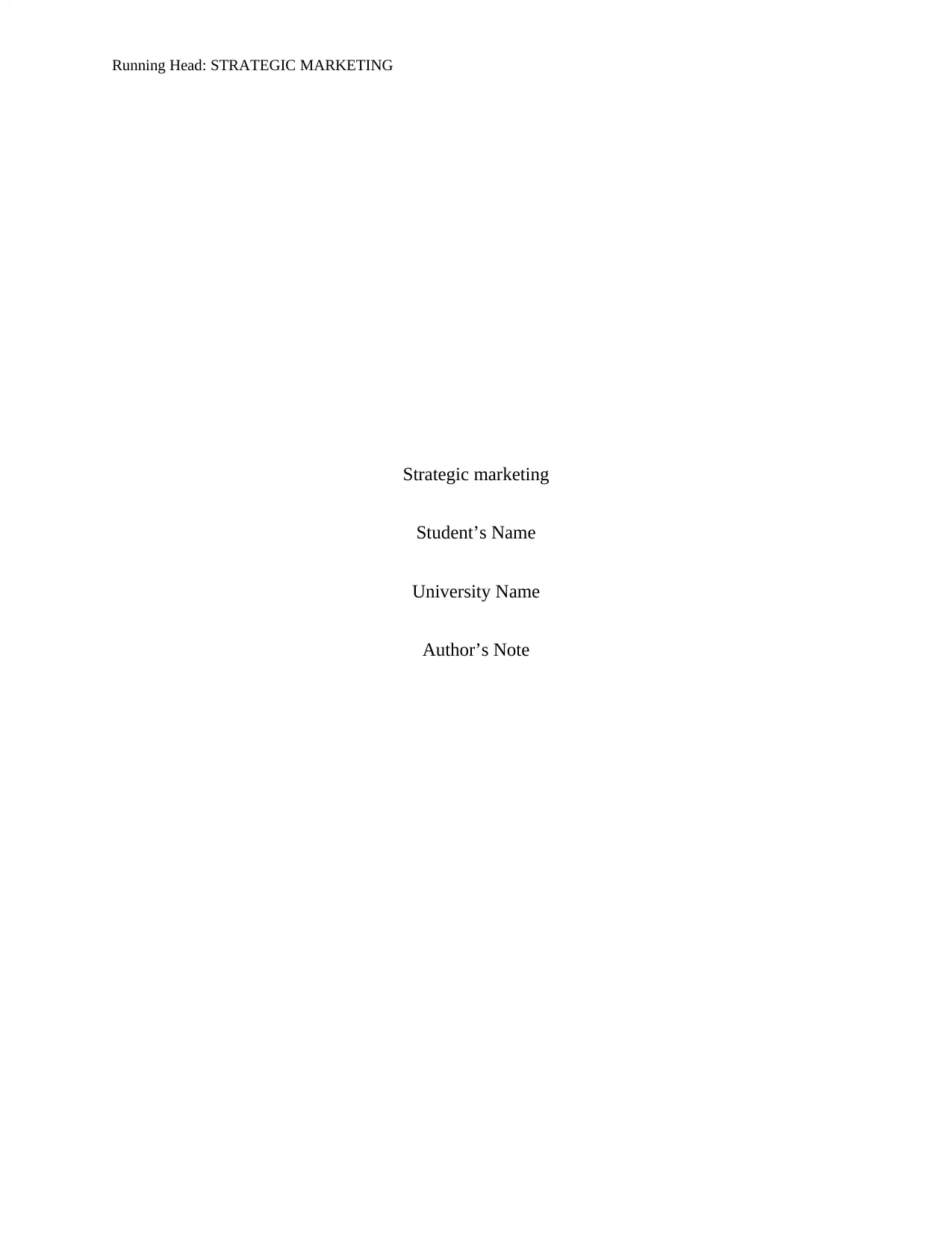
Running Head: STRATEGIC MARKETING
Strategic marketing
Student’s Name
University Name
Author’s Note
Strategic marketing
Student’s Name
University Name
Author’s Note
Paraphrase This Document
Need a fresh take? Get an instant paraphrase of this document with our AI Paraphraser
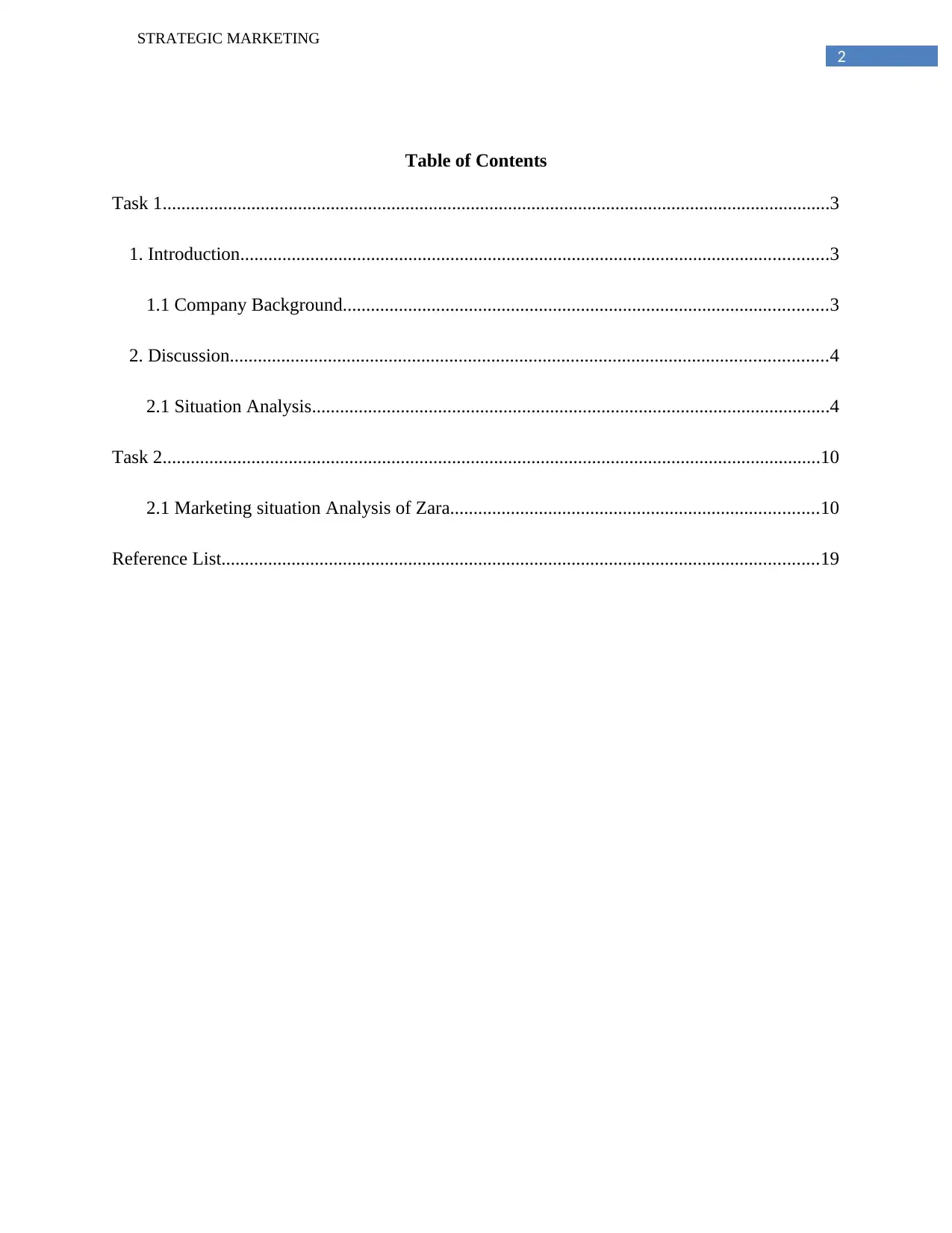
2
STRATEGIC MARKETING
Table of Contents
Task 1...............................................................................................................................................3
1. Introduction..............................................................................................................................3
1.1 Company Background........................................................................................................3
2. Discussion................................................................................................................................4
2.1 Situation Analysis...............................................................................................................4
Task 2.............................................................................................................................................10
2.1 Marketing situation Analysis of Zara...............................................................................10
Reference List................................................................................................................................19
STRATEGIC MARKETING
Table of Contents
Task 1...............................................................................................................................................3
1. Introduction..............................................................................................................................3
1.1 Company Background........................................................................................................3
2. Discussion................................................................................................................................4
2.1 Situation Analysis...............................................................................................................4
Task 2.............................................................................................................................................10
2.1 Marketing situation Analysis of Zara...............................................................................10
Reference List................................................................................................................................19
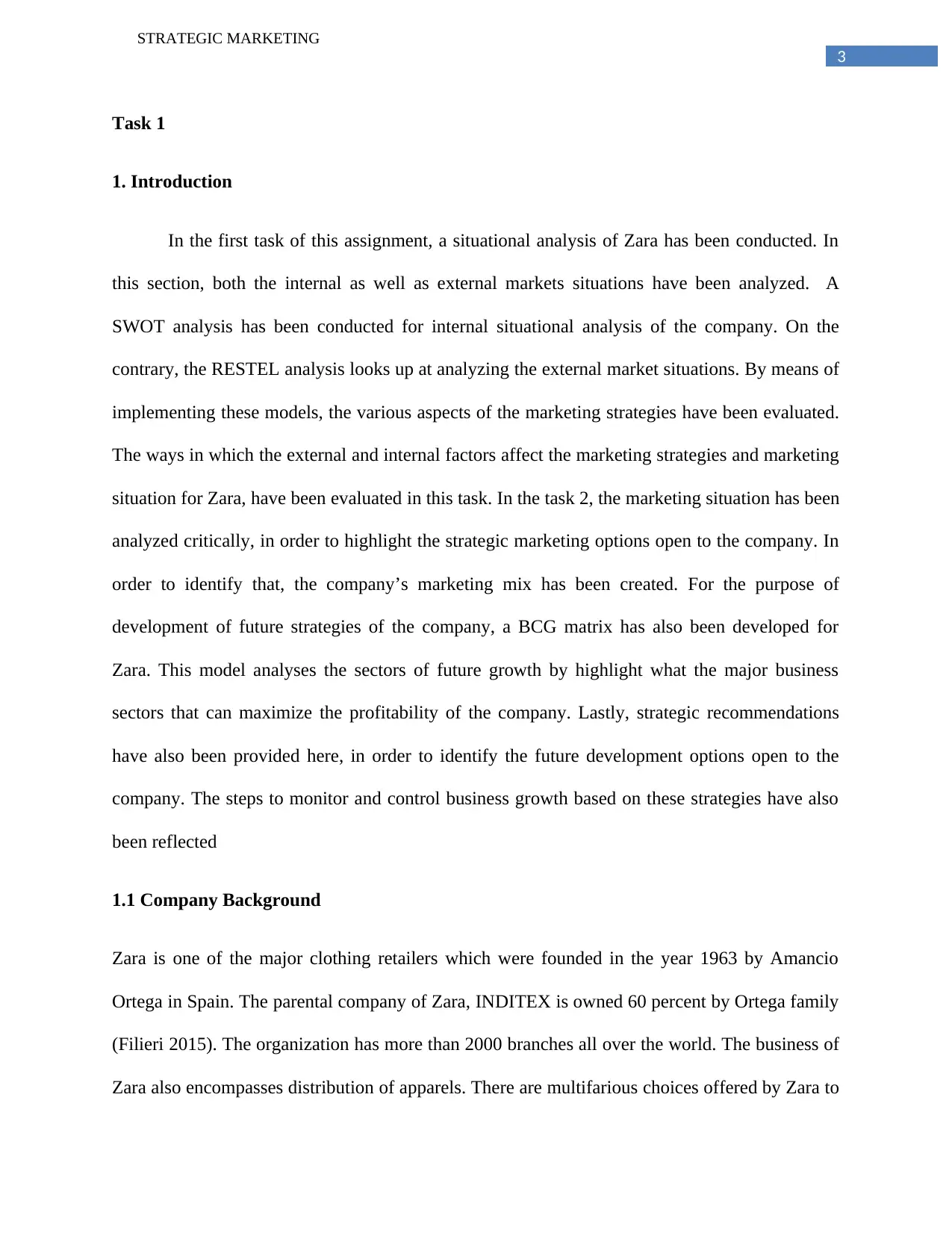
3
STRATEGIC MARKETING
Task 1
1. Introduction
In the first task of this assignment, a situational analysis of Zara has been conducted. In
this section, both the internal as well as external markets situations have been analyzed. A
SWOT analysis has been conducted for internal situational analysis of the company. On the
contrary, the RESTEL analysis looks up at analyzing the external market situations. By means of
implementing these models, the various aspects of the marketing strategies have been evaluated.
The ways in which the external and internal factors affect the marketing strategies and marketing
situation for Zara, have been evaluated in this task. In the task 2, the marketing situation has been
analyzed critically, in order to highlight the strategic marketing options open to the company. In
order to identify that, the company’s marketing mix has been created. For the purpose of
development of future strategies of the company, a BCG matrix has also been developed for
Zara. This model analyses the sectors of future growth by highlight what the major business
sectors that can maximize the profitability of the company. Lastly, strategic recommendations
have also been provided here, in order to identify the future development options open to the
company. The steps to monitor and control business growth based on these strategies have also
been reflected
1.1 Company Background
Zara is one of the major clothing retailers which were founded in the year 1963 by Amancio
Ortega in Spain. The parental company of Zara, INDITEX is owned 60 percent by Ortega family
(Filieri 2015). The organization has more than 2000 branches all over the world. The business of
Zara also encompasses distribution of apparels. There are multifarious choices offered by Zara to
STRATEGIC MARKETING
Task 1
1. Introduction
In the first task of this assignment, a situational analysis of Zara has been conducted. In
this section, both the internal as well as external markets situations have been analyzed. A
SWOT analysis has been conducted for internal situational analysis of the company. On the
contrary, the RESTEL analysis looks up at analyzing the external market situations. By means of
implementing these models, the various aspects of the marketing strategies have been evaluated.
The ways in which the external and internal factors affect the marketing strategies and marketing
situation for Zara, have been evaluated in this task. In the task 2, the marketing situation has been
analyzed critically, in order to highlight the strategic marketing options open to the company. In
order to identify that, the company’s marketing mix has been created. For the purpose of
development of future strategies of the company, a BCG matrix has also been developed for
Zara. This model analyses the sectors of future growth by highlight what the major business
sectors that can maximize the profitability of the company. Lastly, strategic recommendations
have also been provided here, in order to identify the future development options open to the
company. The steps to monitor and control business growth based on these strategies have also
been reflected
1.1 Company Background
Zara is one of the major clothing retailers which were founded in the year 1963 by Amancio
Ortega in Spain. The parental company of Zara, INDITEX is owned 60 percent by Ortega family
(Filieri 2015). The organization has more than 2000 branches all over the world. The business of
Zara also encompasses distribution of apparels. There are multifarious choices offered by Zara to
⊘ This is a preview!⊘
Do you want full access?
Subscribe today to unlock all pages.

Trusted by 1+ million students worldwide
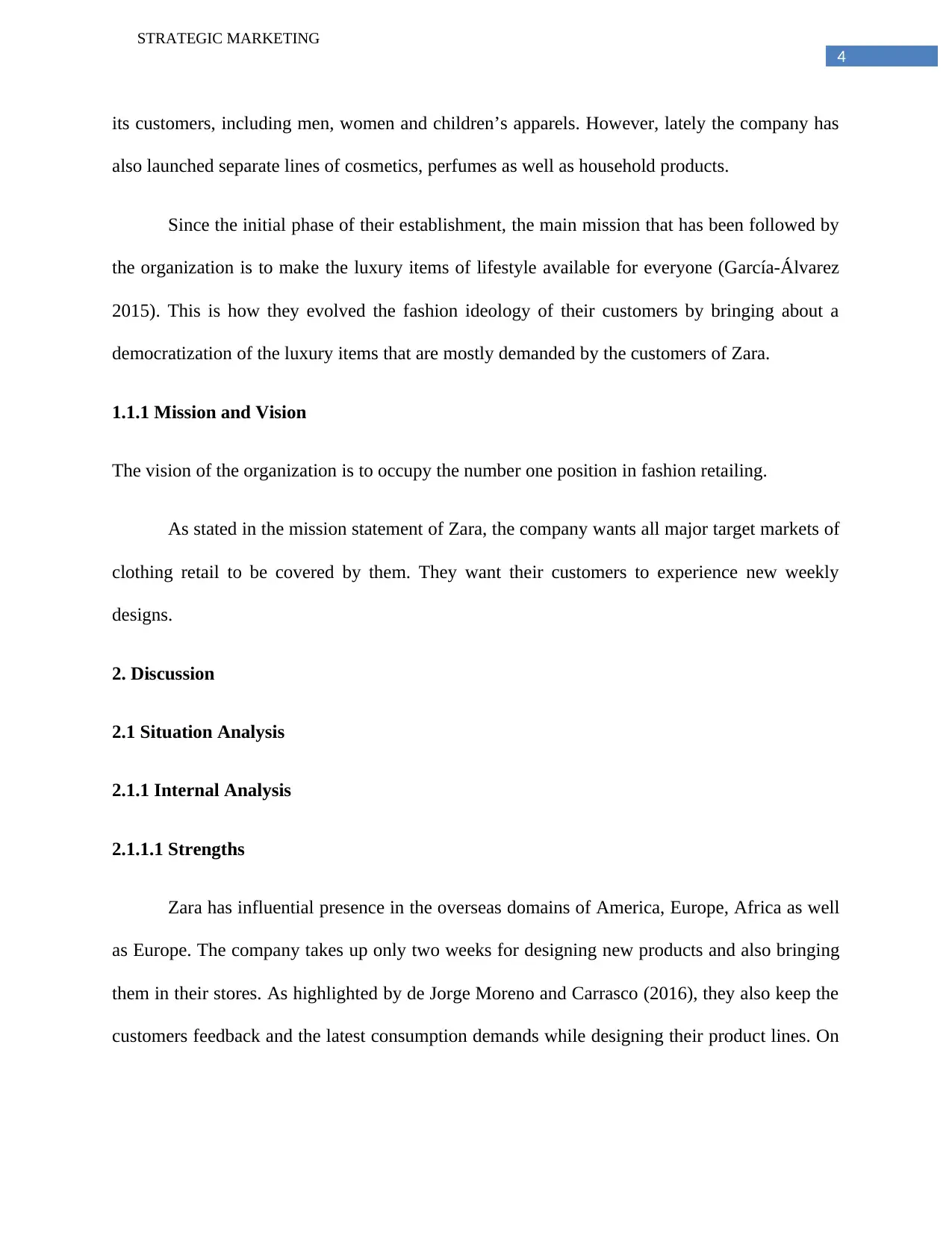
4
STRATEGIC MARKETING
its customers, including men, women and children’s apparels. However, lately the company has
also launched separate lines of cosmetics, perfumes as well as household products.
Since the initial phase of their establishment, the main mission that has been followed by
the organization is to make the luxury items of lifestyle available for everyone (García-Álvarez
2015). This is how they evolved the fashion ideology of their customers by bringing about a
democratization of the luxury items that are mostly demanded by the customers of Zara.
1.1.1 Mission and Vision
The vision of the organization is to occupy the number one position in fashion retailing.
As stated in the mission statement of Zara, the company wants all major target markets of
clothing retail to be covered by them. They want their customers to experience new weekly
designs.
2. Discussion
2.1 Situation Analysis
2.1.1 Internal Analysis
2.1.1.1 Strengths
Zara has influential presence in the overseas domains of America, Europe, Africa as well
as Europe. The company takes up only two weeks for designing new products and also bringing
them in their stores. As highlighted by de Jorge Moreno and Carrasco (2016), they also keep the
customers feedback and the latest consumption demands while designing their product lines. On
STRATEGIC MARKETING
its customers, including men, women and children’s apparels. However, lately the company has
also launched separate lines of cosmetics, perfumes as well as household products.
Since the initial phase of their establishment, the main mission that has been followed by
the organization is to make the luxury items of lifestyle available for everyone (García-Álvarez
2015). This is how they evolved the fashion ideology of their customers by bringing about a
democratization of the luxury items that are mostly demanded by the customers of Zara.
1.1.1 Mission and Vision
The vision of the organization is to occupy the number one position in fashion retailing.
As stated in the mission statement of Zara, the company wants all major target markets of
clothing retail to be covered by them. They want their customers to experience new weekly
designs.
2. Discussion
2.1 Situation Analysis
2.1.1 Internal Analysis
2.1.1.1 Strengths
Zara has influential presence in the overseas domains of America, Europe, Africa as well
as Europe. The company takes up only two weeks for designing new products and also bringing
them in their stores. As highlighted by de Jorge Moreno and Carrasco (2016), they also keep the
customers feedback and the latest consumption demands while designing their product lines. On
Paraphrase This Document
Need a fresh take? Get an instant paraphrase of this document with our AI Paraphraser
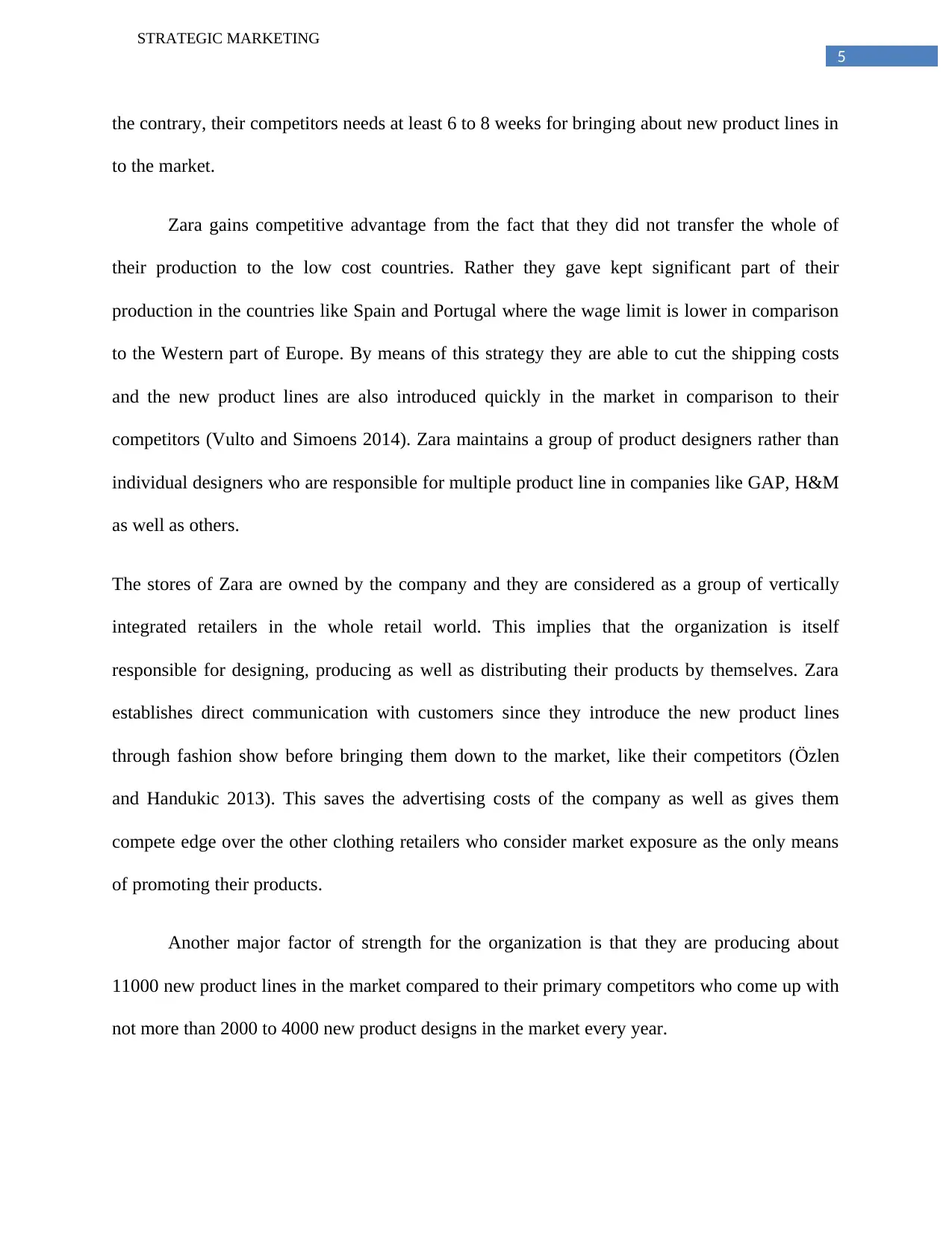
5
STRATEGIC MARKETING
the contrary, their competitors needs at least 6 to 8 weeks for bringing about new product lines in
to the market.
Zara gains competitive advantage from the fact that they did not transfer the whole of
their production to the low cost countries. Rather they gave kept significant part of their
production in the countries like Spain and Portugal where the wage limit is lower in comparison
to the Western part of Europe. By means of this strategy they are able to cut the shipping costs
and the new product lines are also introduced quickly in the market in comparison to their
competitors (Vulto and Simoens 2014). Zara maintains a group of product designers rather than
individual designers who are responsible for multiple product line in companies like GAP, H&M
as well as others.
The stores of Zara are owned by the company and they are considered as a group of vertically
integrated retailers in the whole retail world. This implies that the organization is itself
responsible for designing, producing as well as distributing their products by themselves. Zara
establishes direct communication with customers since they introduce the new product lines
through fashion show before bringing them down to the market, like their competitors (Özlen
and Handukic 2013). This saves the advertising costs of the company as well as gives them
compete edge over the other clothing retailers who consider market exposure as the only means
of promoting their products.
Another major factor of strength for the organization is that they are producing about
11000 new product lines in the market compared to their primary competitors who come up with
not more than 2000 to 4000 new product designs in the market every year.
STRATEGIC MARKETING
the contrary, their competitors needs at least 6 to 8 weeks for bringing about new product lines in
to the market.
Zara gains competitive advantage from the fact that they did not transfer the whole of
their production to the low cost countries. Rather they gave kept significant part of their
production in the countries like Spain and Portugal where the wage limit is lower in comparison
to the Western part of Europe. By means of this strategy they are able to cut the shipping costs
and the new product lines are also introduced quickly in the market in comparison to their
competitors (Vulto and Simoens 2014). Zara maintains a group of product designers rather than
individual designers who are responsible for multiple product line in companies like GAP, H&M
as well as others.
The stores of Zara are owned by the company and they are considered as a group of vertically
integrated retailers in the whole retail world. This implies that the organization is itself
responsible for designing, producing as well as distributing their products by themselves. Zara
establishes direct communication with customers since they introduce the new product lines
through fashion show before bringing them down to the market, like their competitors (Özlen
and Handukic 2013). This saves the advertising costs of the company as well as gives them
compete edge over the other clothing retailers who consider market exposure as the only means
of promoting their products.
Another major factor of strength for the organization is that they are producing about
11000 new product lines in the market compared to their primary competitors who come up with
not more than 2000 to 4000 new product designs in the market every year.
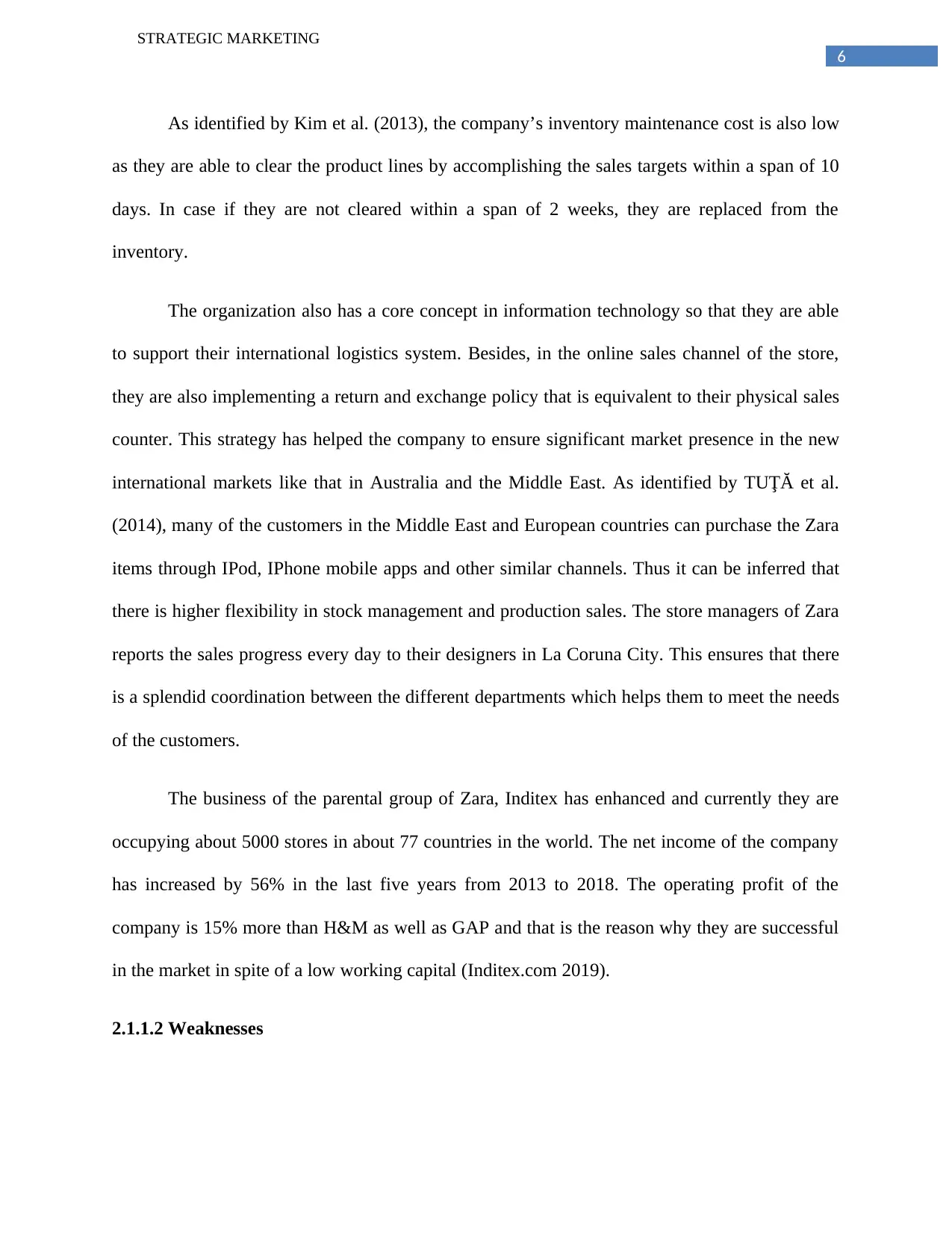
6
STRATEGIC MARKETING
As identified by Kim et al. (2013), the company’s inventory maintenance cost is also low
as they are able to clear the product lines by accomplishing the sales targets within a span of 10
days. In case if they are not cleared within a span of 2 weeks, they are replaced from the
inventory.
The organization also has a core concept in information technology so that they are able
to support their international logistics system. Besides, in the online sales channel of the store,
they are also implementing a return and exchange policy that is equivalent to their physical sales
counter. This strategy has helped the company to ensure significant market presence in the new
international markets like that in Australia and the Middle East. As identified by TUŢĂ et al.
(2014), many of the customers in the Middle East and European countries can purchase the Zara
items through IPod, IPhone mobile apps and other similar channels. Thus it can be inferred that
there is higher flexibility in stock management and production sales. The store managers of Zara
reports the sales progress every day to their designers in La Coruna City. This ensures that there
is a splendid coordination between the different departments which helps them to meet the needs
of the customers.
The business of the parental group of Zara, Inditex has enhanced and currently they are
occupying about 5000 stores in about 77 countries in the world. The net income of the company
has increased by 56% in the last five years from 2013 to 2018. The operating profit of the
company is 15% more than H&M as well as GAP and that is the reason why they are successful
in the market in spite of a low working capital (Inditex.com 2019).
2.1.1.2 Weaknesses
STRATEGIC MARKETING
As identified by Kim et al. (2013), the company’s inventory maintenance cost is also low
as they are able to clear the product lines by accomplishing the sales targets within a span of 10
days. In case if they are not cleared within a span of 2 weeks, they are replaced from the
inventory.
The organization also has a core concept in information technology so that they are able
to support their international logistics system. Besides, in the online sales channel of the store,
they are also implementing a return and exchange policy that is equivalent to their physical sales
counter. This strategy has helped the company to ensure significant market presence in the new
international markets like that in Australia and the Middle East. As identified by TUŢĂ et al.
(2014), many of the customers in the Middle East and European countries can purchase the Zara
items through IPod, IPhone mobile apps and other similar channels. Thus it can be inferred that
there is higher flexibility in stock management and production sales. The store managers of Zara
reports the sales progress every day to their designers in La Coruna City. This ensures that there
is a splendid coordination between the different departments which helps them to meet the needs
of the customers.
The business of the parental group of Zara, Inditex has enhanced and currently they are
occupying about 5000 stores in about 77 countries in the world. The net income of the company
has increased by 56% in the last five years from 2013 to 2018. The operating profit of the
company is 15% more than H&M as well as GAP and that is the reason why they are successful
in the market in spite of a low working capital (Inditex.com 2019).
2.1.1.2 Weaknesses
⊘ This is a preview!⊘
Do you want full access?
Subscribe today to unlock all pages.

Trusted by 1+ million students worldwide
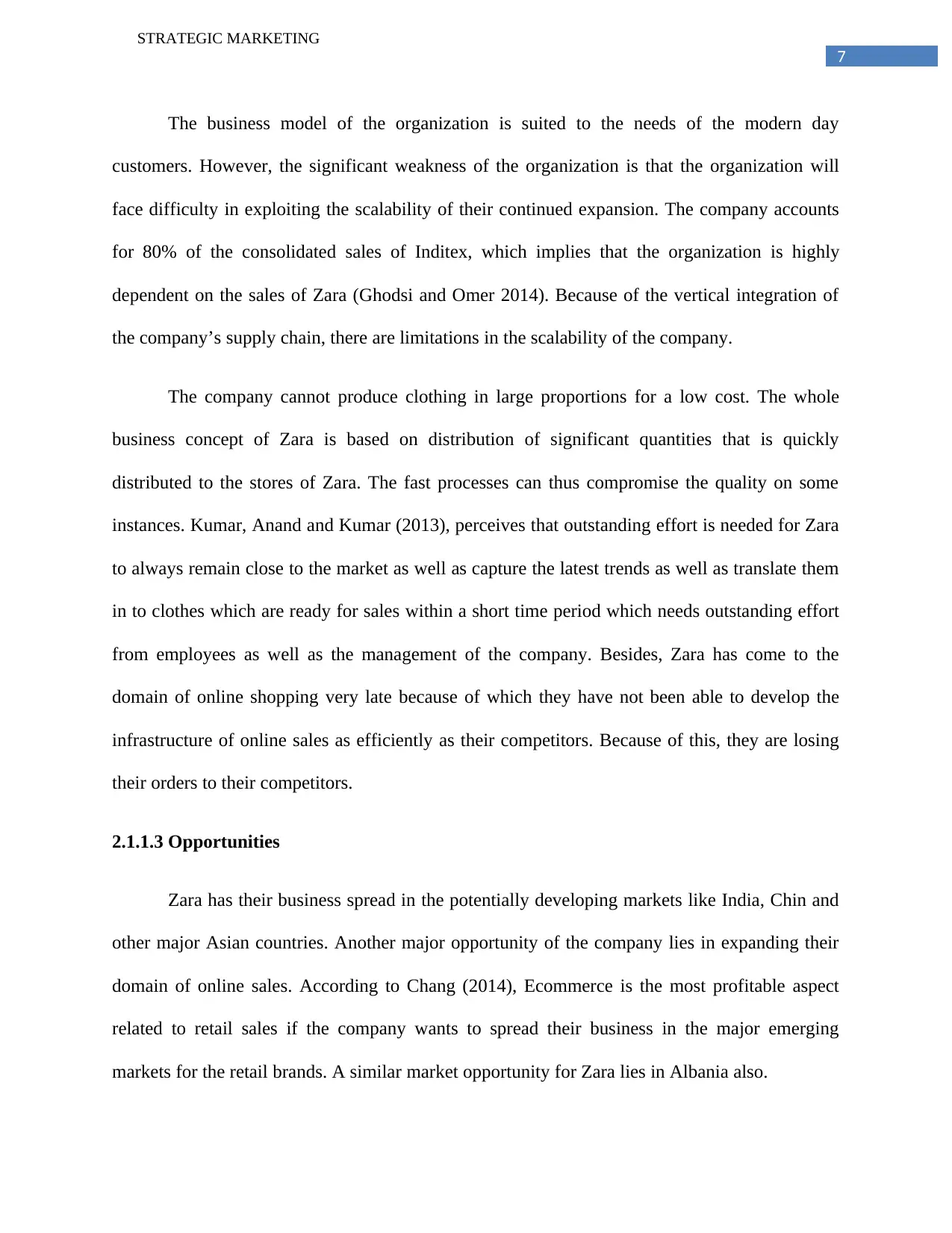
7
STRATEGIC MARKETING
The business model of the organization is suited to the needs of the modern day
customers. However, the significant weakness of the organization is that the organization will
face difficulty in exploiting the scalability of their continued expansion. The company accounts
for 80% of the consolidated sales of Inditex, which implies that the organization is highly
dependent on the sales of Zara (Ghodsi and Omer 2014). Because of the vertical integration of
the company’s supply chain, there are limitations in the scalability of the company.
The company cannot produce clothing in large proportions for a low cost. The whole
business concept of Zara is based on distribution of significant quantities that is quickly
distributed to the stores of Zara. The fast processes can thus compromise the quality on some
instances. Kumar, Anand and Kumar (2013), perceives that outstanding effort is needed for Zara
to always remain close to the market as well as capture the latest trends as well as translate them
in to clothes which are ready for sales within a short time period which needs outstanding effort
from employees as well as the management of the company. Besides, Zara has come to the
domain of online shopping very late because of which they have not been able to develop the
infrastructure of online sales as efficiently as their competitors. Because of this, they are losing
their orders to their competitors.
2.1.1.3 Opportunities
Zara has their business spread in the potentially developing markets like India, Chin and
other major Asian countries. Another major opportunity of the company lies in expanding their
domain of online sales. According to Chang (2014), Ecommerce is the most profitable aspect
related to retail sales if the company wants to spread their business in the major emerging
markets for the retail brands. A similar market opportunity for Zara lies in Albania also.
STRATEGIC MARKETING
The business model of the organization is suited to the needs of the modern day
customers. However, the significant weakness of the organization is that the organization will
face difficulty in exploiting the scalability of their continued expansion. The company accounts
for 80% of the consolidated sales of Inditex, which implies that the organization is highly
dependent on the sales of Zara (Ghodsi and Omer 2014). Because of the vertical integration of
the company’s supply chain, there are limitations in the scalability of the company.
The company cannot produce clothing in large proportions for a low cost. The whole
business concept of Zara is based on distribution of significant quantities that is quickly
distributed to the stores of Zara. The fast processes can thus compromise the quality on some
instances. Kumar, Anand and Kumar (2013), perceives that outstanding effort is needed for Zara
to always remain close to the market as well as capture the latest trends as well as translate them
in to clothes which are ready for sales within a short time period which needs outstanding effort
from employees as well as the management of the company. Besides, Zara has come to the
domain of online shopping very late because of which they have not been able to develop the
infrastructure of online sales as efficiently as their competitors. Because of this, they are losing
their orders to their competitors.
2.1.1.3 Opportunities
Zara has their business spread in the potentially developing markets like India, Chin and
other major Asian countries. Another major opportunity of the company lies in expanding their
domain of online sales. According to Chang (2014), Ecommerce is the most profitable aspect
related to retail sales if the company wants to spread their business in the major emerging
markets for the retail brands. A similar market opportunity for Zara lies in Albania also.
Paraphrase This Document
Need a fresh take? Get an instant paraphrase of this document with our AI Paraphraser
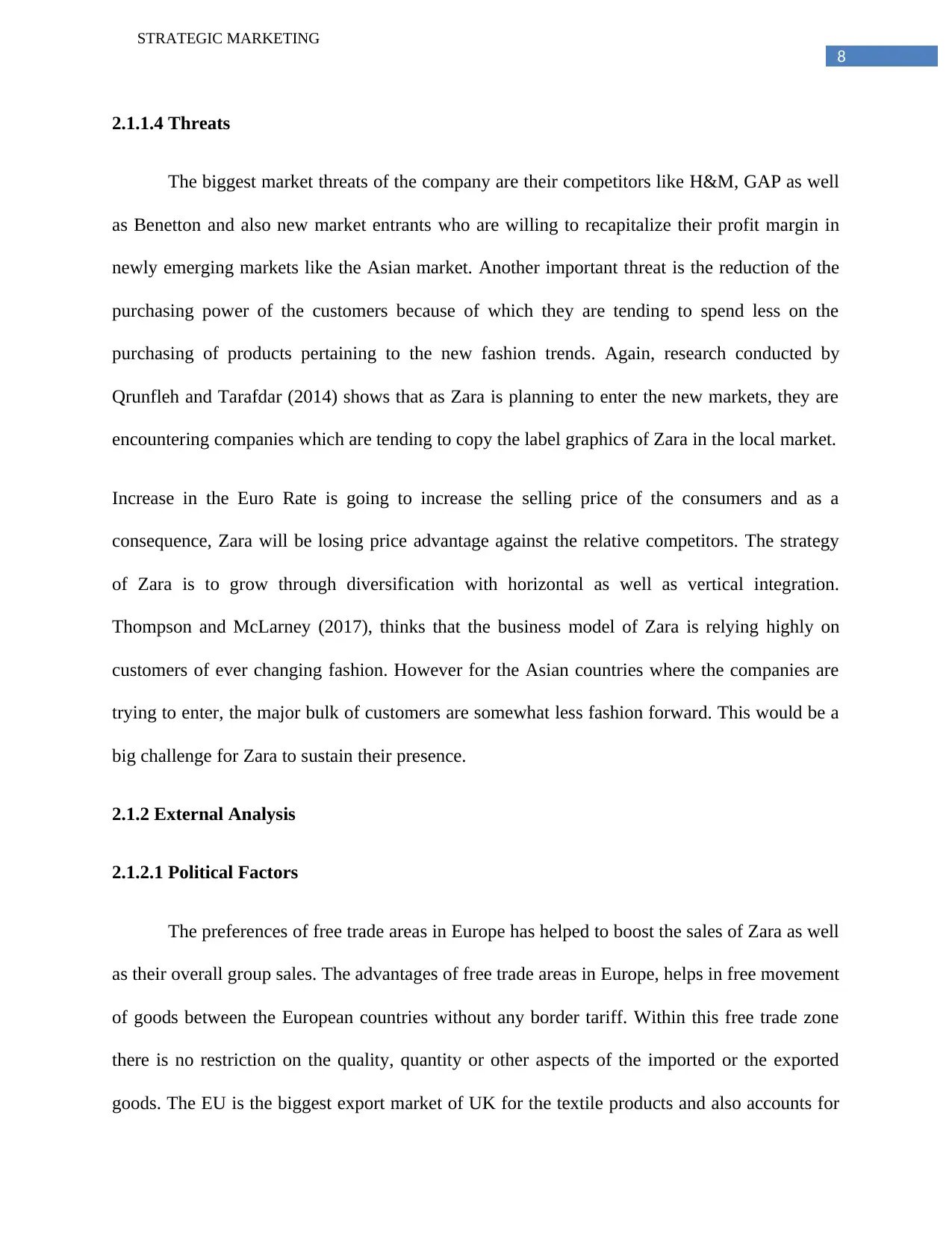
8
STRATEGIC MARKETING
2.1.1.4 Threats
The biggest market threats of the company are their competitors like H&M, GAP as well
as Benetton and also new market entrants who are willing to recapitalize their profit margin in
newly emerging markets like the Asian market. Another important threat is the reduction of the
purchasing power of the customers because of which they are tending to spend less on the
purchasing of products pertaining to the new fashion trends. Again, research conducted by
Qrunfleh and Tarafdar (2014) shows that as Zara is planning to enter the new markets, they are
encountering companies which are tending to copy the label graphics of Zara in the local market.
Increase in the Euro Rate is going to increase the selling price of the consumers and as a
consequence, Zara will be losing price advantage against the relative competitors. The strategy
of Zara is to grow through diversification with horizontal as well as vertical integration.
Thompson and McLarney (2017), thinks that the business model of Zara is relying highly on
customers of ever changing fashion. However for the Asian countries where the companies are
trying to enter, the major bulk of customers are somewhat less fashion forward. This would be a
big challenge for Zara to sustain their presence.
2.1.2 External Analysis
2.1.2.1 Political Factors
The preferences of free trade areas in Europe has helped to boost the sales of Zara as well
as their overall group sales. The advantages of free trade areas in Europe, helps in free movement
of goods between the European countries without any border tariff. Within this free trade zone
there is no restriction on the quality, quantity or other aspects of the imported or the exported
goods. The EU is the biggest export market of UK for the textile products and also accounts for
STRATEGIC MARKETING
2.1.1.4 Threats
The biggest market threats of the company are their competitors like H&M, GAP as well
as Benetton and also new market entrants who are willing to recapitalize their profit margin in
newly emerging markets like the Asian market. Another important threat is the reduction of the
purchasing power of the customers because of which they are tending to spend less on the
purchasing of products pertaining to the new fashion trends. Again, research conducted by
Qrunfleh and Tarafdar (2014) shows that as Zara is planning to enter the new markets, they are
encountering companies which are tending to copy the label graphics of Zara in the local market.
Increase in the Euro Rate is going to increase the selling price of the consumers and as a
consequence, Zara will be losing price advantage against the relative competitors. The strategy
of Zara is to grow through diversification with horizontal as well as vertical integration.
Thompson and McLarney (2017), thinks that the business model of Zara is relying highly on
customers of ever changing fashion. However for the Asian countries where the companies are
trying to enter, the major bulk of customers are somewhat less fashion forward. This would be a
big challenge for Zara to sustain their presence.
2.1.2 External Analysis
2.1.2.1 Political Factors
The preferences of free trade areas in Europe has helped to boost the sales of Zara as well
as their overall group sales. The advantages of free trade areas in Europe, helps in free movement
of goods between the European countries without any border tariff. Within this free trade zone
there is no restriction on the quality, quantity or other aspects of the imported or the exported
goods. The EU is the biggest export market of UK for the textile products and also accounts for
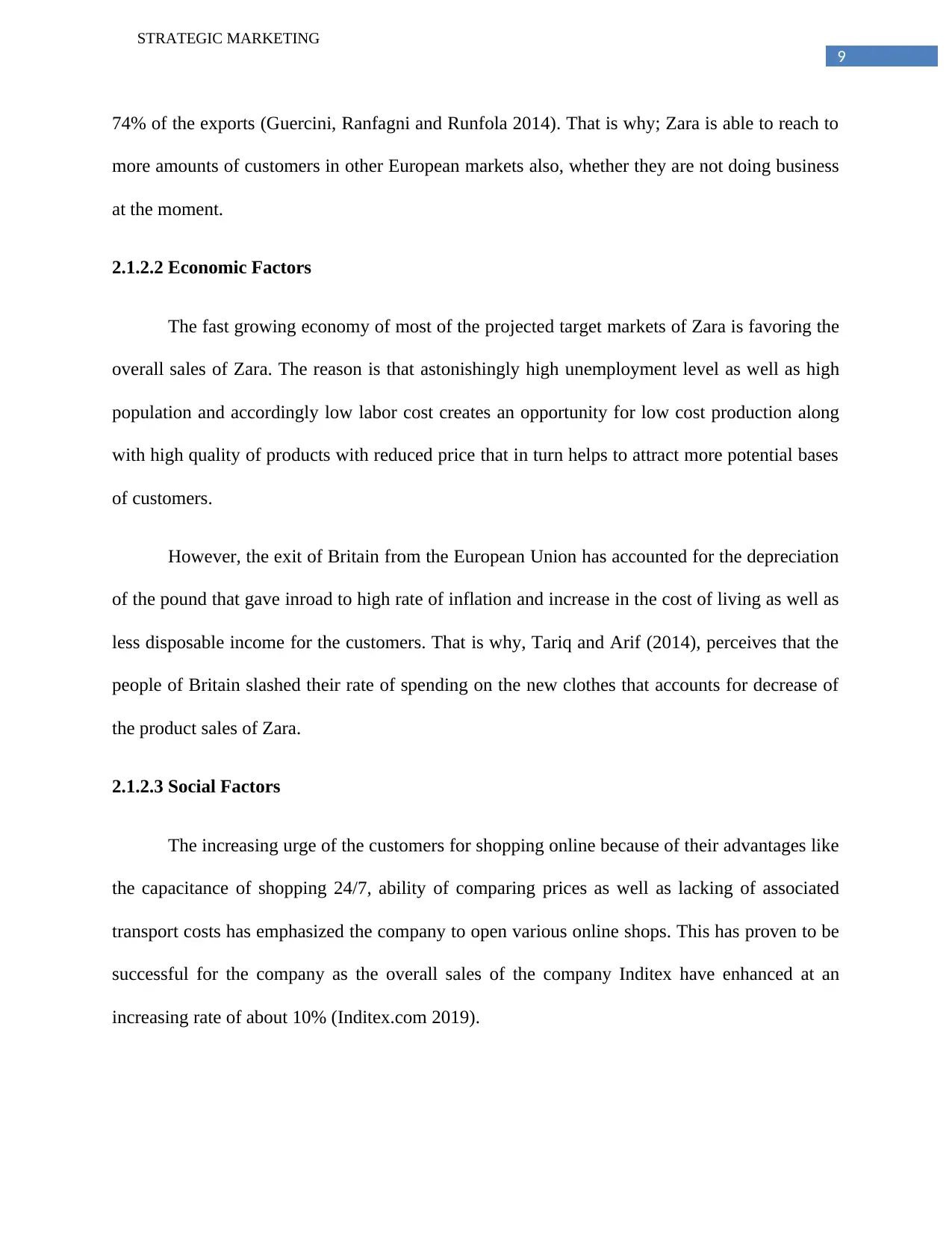
9
STRATEGIC MARKETING
74% of the exports (Guercini, Ranfagni and Runfola 2014). That is why; Zara is able to reach to
more amounts of customers in other European markets also, whether they are not doing business
at the moment.
2.1.2.2 Economic Factors
The fast growing economy of most of the projected target markets of Zara is favoring the
overall sales of Zara. The reason is that astonishingly high unemployment level as well as high
population and accordingly low labor cost creates an opportunity for low cost production along
with high quality of products with reduced price that in turn helps to attract more potential bases
of customers.
However, the exit of Britain from the European Union has accounted for the depreciation
of the pound that gave inroad to high rate of inflation and increase in the cost of living as well as
less disposable income for the customers. That is why, Tariq and Arif (2014), perceives that the
people of Britain slashed their rate of spending on the new clothes that accounts for decrease of
the product sales of Zara.
2.1.2.3 Social Factors
The increasing urge of the customers for shopping online because of their advantages like
the capacitance of shopping 24/7, ability of comparing prices as well as lacking of associated
transport costs has emphasized the company to open various online shops. This has proven to be
successful for the company as the overall sales of the company Inditex have enhanced at an
increasing rate of about 10% (Inditex.com 2019).
STRATEGIC MARKETING
74% of the exports (Guercini, Ranfagni and Runfola 2014). That is why; Zara is able to reach to
more amounts of customers in other European markets also, whether they are not doing business
at the moment.
2.1.2.2 Economic Factors
The fast growing economy of most of the projected target markets of Zara is favoring the
overall sales of Zara. The reason is that astonishingly high unemployment level as well as high
population and accordingly low labor cost creates an opportunity for low cost production along
with high quality of products with reduced price that in turn helps to attract more potential bases
of customers.
However, the exit of Britain from the European Union has accounted for the depreciation
of the pound that gave inroad to high rate of inflation and increase in the cost of living as well as
less disposable income for the customers. That is why, Tariq and Arif (2014), perceives that the
people of Britain slashed their rate of spending on the new clothes that accounts for decrease of
the product sales of Zara.
2.1.2.3 Social Factors
The increasing urge of the customers for shopping online because of their advantages like
the capacitance of shopping 24/7, ability of comparing prices as well as lacking of associated
transport costs has emphasized the company to open various online shops. This has proven to be
successful for the company as the overall sales of the company Inditex have enhanced at an
increasing rate of about 10% (Inditex.com 2019).
⊘ This is a preview!⊘
Do you want full access?
Subscribe today to unlock all pages.

Trusted by 1+ million students worldwide
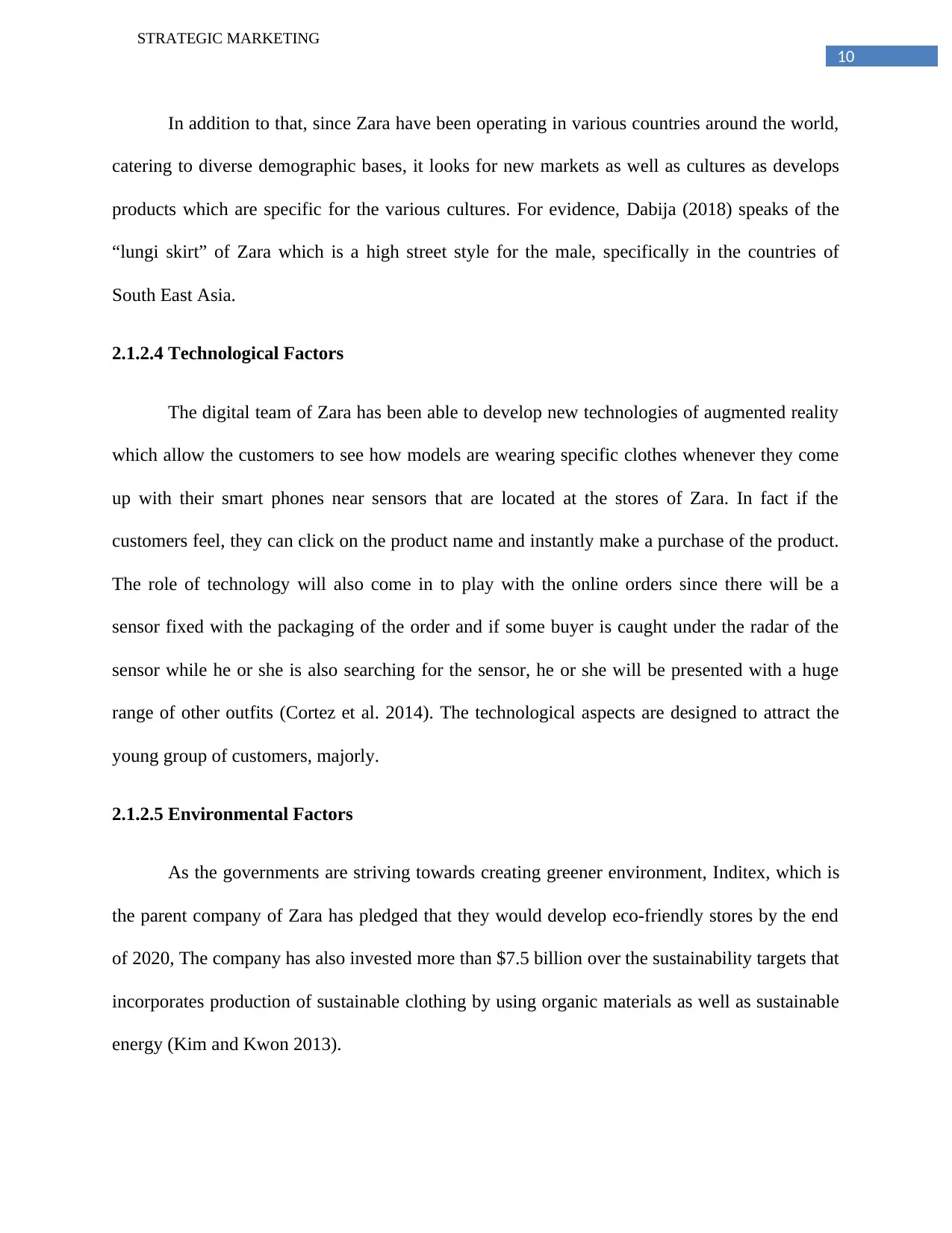
10
STRATEGIC MARKETING
In addition to that, since Zara have been operating in various countries around the world,
catering to diverse demographic bases, it looks for new markets as well as cultures as develops
products which are specific for the various cultures. For evidence, Dabija (2018) speaks of the
“lungi skirt” of Zara which is a high street style for the male, specifically in the countries of
South East Asia.
2.1.2.4 Technological Factors
The digital team of Zara has been able to develop new technologies of augmented reality
which allow the customers to see how models are wearing specific clothes whenever they come
up with their smart phones near sensors that are located at the stores of Zara. In fact if the
customers feel, they can click on the product name and instantly make a purchase of the product.
The role of technology will also come in to play with the online orders since there will be a
sensor fixed with the packaging of the order and if some buyer is caught under the radar of the
sensor while he or she is also searching for the sensor, he or she will be presented with a huge
range of other outfits (Cortez et al. 2014). The technological aspects are designed to attract the
young group of customers, majorly.
2.1.2.5 Environmental Factors
As the governments are striving towards creating greener environment, Inditex, which is
the parent company of Zara has pledged that they would develop eco-friendly stores by the end
of 2020, The company has also invested more than $7.5 billion over the sustainability targets that
incorporates production of sustainable clothing by using organic materials as well as sustainable
energy (Kim and Kwon 2013).
STRATEGIC MARKETING
In addition to that, since Zara have been operating in various countries around the world,
catering to diverse demographic bases, it looks for new markets as well as cultures as develops
products which are specific for the various cultures. For evidence, Dabija (2018) speaks of the
“lungi skirt” of Zara which is a high street style for the male, specifically in the countries of
South East Asia.
2.1.2.4 Technological Factors
The digital team of Zara has been able to develop new technologies of augmented reality
which allow the customers to see how models are wearing specific clothes whenever they come
up with their smart phones near sensors that are located at the stores of Zara. In fact if the
customers feel, they can click on the product name and instantly make a purchase of the product.
The role of technology will also come in to play with the online orders since there will be a
sensor fixed with the packaging of the order and if some buyer is caught under the radar of the
sensor while he or she is also searching for the sensor, he or she will be presented with a huge
range of other outfits (Cortez et al. 2014). The technological aspects are designed to attract the
young group of customers, majorly.
2.1.2.5 Environmental Factors
As the governments are striving towards creating greener environment, Inditex, which is
the parent company of Zara has pledged that they would develop eco-friendly stores by the end
of 2020, The company has also invested more than $7.5 billion over the sustainability targets that
incorporates production of sustainable clothing by using organic materials as well as sustainable
energy (Kim and Kwon 2013).
Paraphrase This Document
Need a fresh take? Get an instant paraphrase of this document with our AI Paraphraser
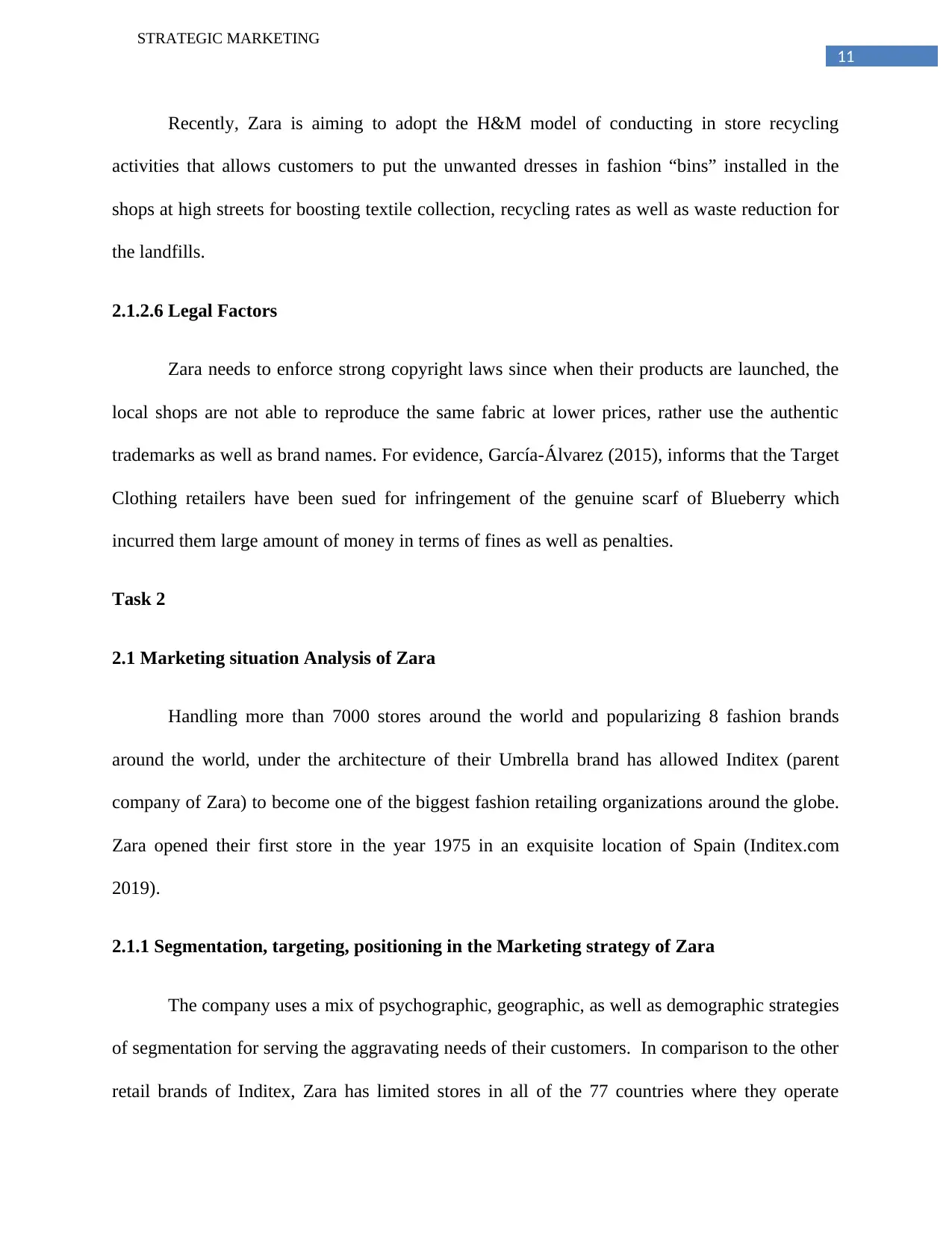
11
STRATEGIC MARKETING
Recently, Zara is aiming to adopt the H&M model of conducting in store recycling
activities that allows customers to put the unwanted dresses in fashion “bins” installed in the
shops at high streets for boosting textile collection, recycling rates as well as waste reduction for
the landfills.
2.1.2.6 Legal Factors
Zara needs to enforce strong copyright laws since when their products are launched, the
local shops are not able to reproduce the same fabric at lower prices, rather use the authentic
trademarks as well as brand names. For evidence, García-Álvarez (2015), informs that the Target
Clothing retailers have been sued for infringement of the genuine scarf of Blueberry which
incurred them large amount of money in terms of fines as well as penalties.
Task 2
2.1 Marketing situation Analysis of Zara
Handling more than 7000 stores around the world and popularizing 8 fashion brands
around the world, under the architecture of their Umbrella brand has allowed Inditex (parent
company of Zara) to become one of the biggest fashion retailing organizations around the globe.
Zara opened their first store in the year 1975 in an exquisite location of Spain (Inditex.com
2019).
2.1.1 Segmentation, targeting, positioning in the Marketing strategy of Zara
The company uses a mix of psychographic, geographic, as well as demographic strategies
of segmentation for serving the aggravating needs of their customers. In comparison to the other
retail brands of Inditex, Zara has limited stores in all of the 77 countries where they operate
STRATEGIC MARKETING
Recently, Zara is aiming to adopt the H&M model of conducting in store recycling
activities that allows customers to put the unwanted dresses in fashion “bins” installed in the
shops at high streets for boosting textile collection, recycling rates as well as waste reduction for
the landfills.
2.1.2.6 Legal Factors
Zara needs to enforce strong copyright laws since when their products are launched, the
local shops are not able to reproduce the same fabric at lower prices, rather use the authentic
trademarks as well as brand names. For evidence, García-Álvarez (2015), informs that the Target
Clothing retailers have been sued for infringement of the genuine scarf of Blueberry which
incurred them large amount of money in terms of fines as well as penalties.
Task 2
2.1 Marketing situation Analysis of Zara
Handling more than 7000 stores around the world and popularizing 8 fashion brands
around the world, under the architecture of their Umbrella brand has allowed Inditex (parent
company of Zara) to become one of the biggest fashion retailing organizations around the globe.
Zara opened their first store in the year 1975 in an exquisite location of Spain (Inditex.com
2019).
2.1.1 Segmentation, targeting, positioning in the Marketing strategy of Zara
The company uses a mix of psychographic, geographic, as well as demographic strategies
of segmentation for serving the aggravating needs of their customers. In comparison to the other
retail brands of Inditex, Zara has limited stores in all of the 77 countries where they operate
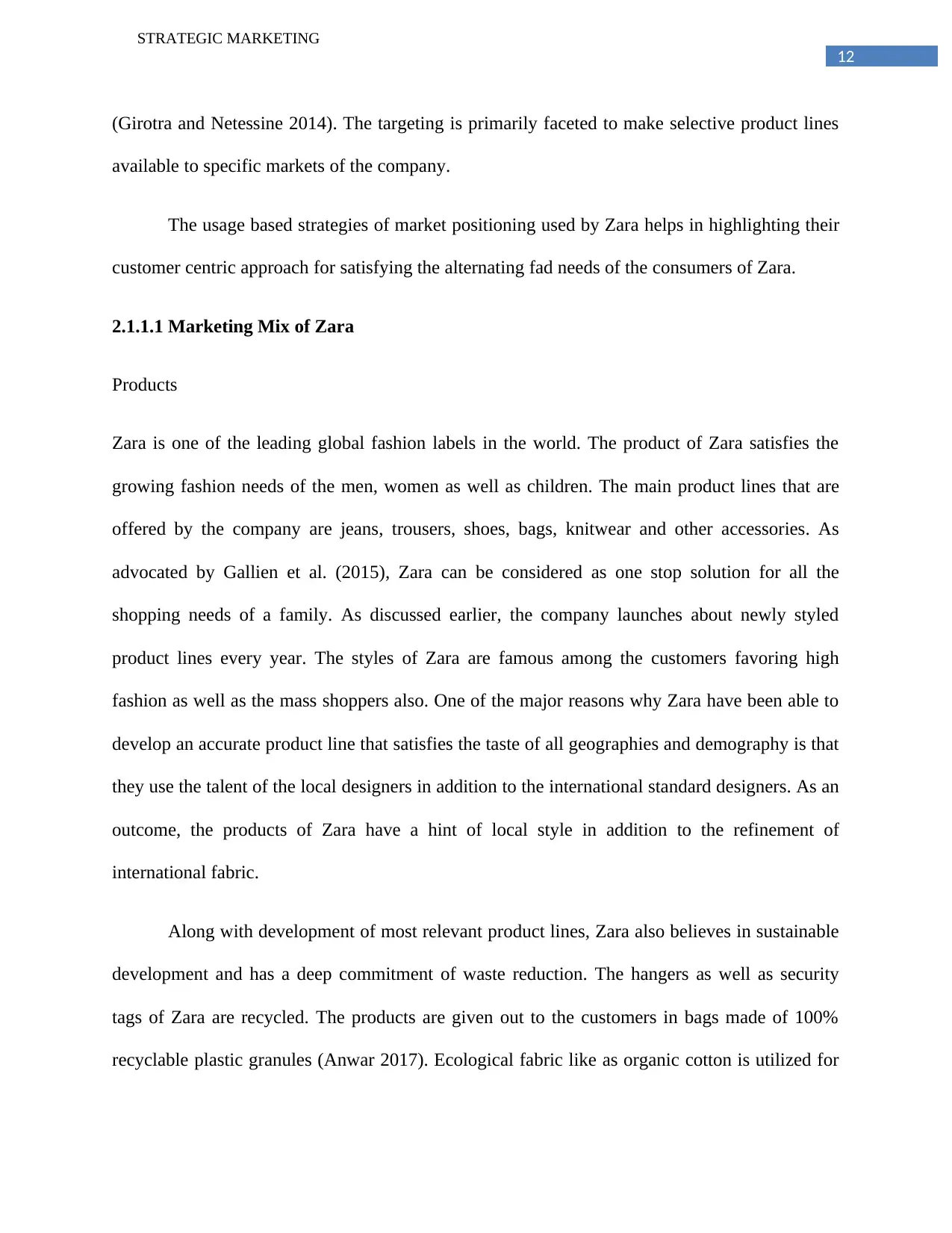
12
STRATEGIC MARKETING
(Girotra and Netessine 2014). The targeting is primarily faceted to make selective product lines
available to specific markets of the company.
The usage based strategies of market positioning used by Zara helps in highlighting their
customer centric approach for satisfying the alternating fad needs of the consumers of Zara.
2.1.1.1 Marketing Mix of Zara
Products
Zara is one of the leading global fashion labels in the world. The product of Zara satisfies the
growing fashion needs of the men, women as well as children. The main product lines that are
offered by the company are jeans, trousers, shoes, bags, knitwear and other accessories. As
advocated by Gallien et al. (2015), Zara can be considered as one stop solution for all the
shopping needs of a family. As discussed earlier, the company launches about newly styled
product lines every year. The styles of Zara are famous among the customers favoring high
fashion as well as the mass shoppers also. One of the major reasons why Zara have been able to
develop an accurate product line that satisfies the taste of all geographies and demography is that
they use the talent of the local designers in addition to the international standard designers. As an
outcome, the products of Zara have a hint of local style in addition to the refinement of
international fabric.
Along with development of most relevant product lines, Zara also believes in sustainable
development and has a deep commitment of waste reduction. The hangers as well as security
tags of Zara are recycled. The products are given out to the customers in bags made of 100%
recyclable plastic granules (Anwar 2017). Ecological fabric like as organic cotton is utilized for
STRATEGIC MARKETING
(Girotra and Netessine 2014). The targeting is primarily faceted to make selective product lines
available to specific markets of the company.
The usage based strategies of market positioning used by Zara helps in highlighting their
customer centric approach for satisfying the alternating fad needs of the consumers of Zara.
2.1.1.1 Marketing Mix of Zara
Products
Zara is one of the leading global fashion labels in the world. The product of Zara satisfies the
growing fashion needs of the men, women as well as children. The main product lines that are
offered by the company are jeans, trousers, shoes, bags, knitwear and other accessories. As
advocated by Gallien et al. (2015), Zara can be considered as one stop solution for all the
shopping needs of a family. As discussed earlier, the company launches about newly styled
product lines every year. The styles of Zara are famous among the customers favoring high
fashion as well as the mass shoppers also. One of the major reasons why Zara have been able to
develop an accurate product line that satisfies the taste of all geographies and demography is that
they use the talent of the local designers in addition to the international standard designers. As an
outcome, the products of Zara have a hint of local style in addition to the refinement of
international fabric.
Along with development of most relevant product lines, Zara also believes in sustainable
development and has a deep commitment of waste reduction. The hangers as well as security
tags of Zara are recycled. The products are given out to the customers in bags made of 100%
recyclable plastic granules (Anwar 2017). Ecological fabric like as organic cotton is utilized for
⊘ This is a preview!⊘
Do you want full access?
Subscribe today to unlock all pages.

Trusted by 1+ million students worldwide
1 out of 23
Related Documents
Your All-in-One AI-Powered Toolkit for Academic Success.
+13062052269
info@desklib.com
Available 24*7 on WhatsApp / Email
![[object Object]](/_next/static/media/star-bottom.7253800d.svg)
Unlock your academic potential
Copyright © 2020–2025 A2Z Services. All Rights Reserved. Developed and managed by ZUCOL.





